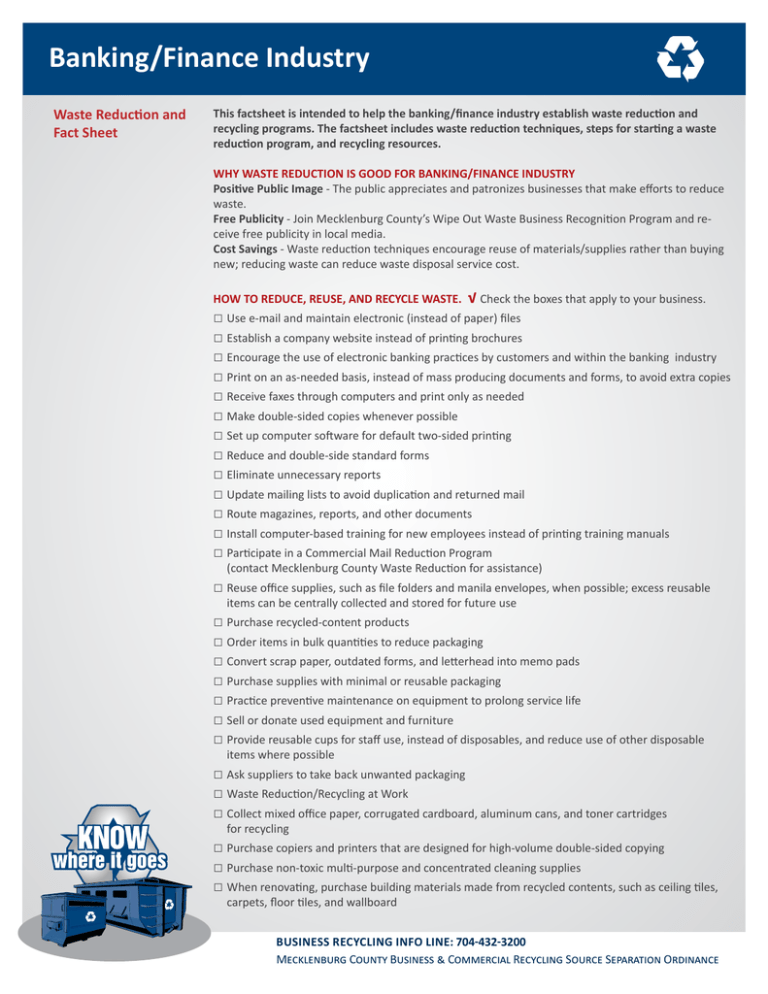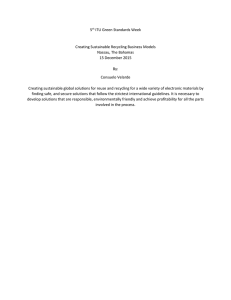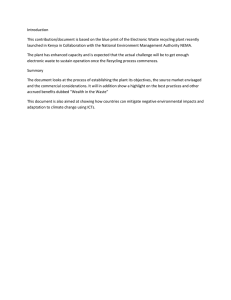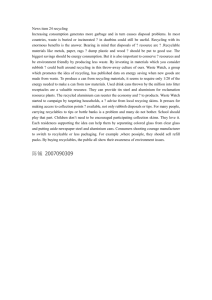Banking/Finance Industry Waste Reduction and
advertisement

Banking/Finance Industry Waste Reduction and Fact Sheet This factsheet is intended to help the banking/finance industry establish waste reduction and recycling programs. The factsheet includes waste reduction techniques, steps for starting a waste reduction program, and recycling resources. WHY WASTE REDUCTION IS GOOD FOR BANKING/FINANCE INDUSTRY Positive Public Image - The public appreciates and patronizes businesses that make efforts to reduce waste. Free Publicity - Join Mecklenburg County’s Wipe Out Waste Business Recognition Program and receive free publicity in local media. Cost Savings - Waste reduction techniques encourage reuse of materials/supplies rather than buying new; reducing waste can reduce waste disposal service cost. HOW TO REDUCE, REUSE, AND RECYCLE WASTE. √ Check the boxes that apply to your business. □ Use e-mail and maintain electronic (instead of paper) files □ Establish a company website instead of printing brochures □ Encourage the use of electronic banking practices by customers and within the banking industry □ Print on an as-needed basis, instead of mass producing documents and forms, to avoid extra copies □ Receive faxes through computers and print only as needed □ Make double-sided copies whenever possible □ Set up computer software for default two-sided printing □ Reduce and double-side standard forms □ Eliminate unnecessary reports □ Update mailing lists to avoid duplication and returned mail □ Route magazines, reports, and other documents □ Install computer-based training for new employees instead of printing training manuals □ Participate in a Commercial Mail Reduction Program (contact Mecklenburg County Waste Reduction for assistance) □ Reuse office supplies, such as file folders and manila envelopes, when possible; excess reusable items can be centrally collected and stored for future use □ Purchase recycled-content products □ Order items in bulk quantities to reduce packaging □ Convert scrap paper, outdated forms, and letterhead into memo pads □ Purchase supplies with minimal or reusable packaging □ Practice preventive maintenance on equipment to prolong service life □ Sell or donate used equipment and furniture □ Provide reusable cups for staff use, instead of disposables, and reduce use of other disposable items where possible □ Ask suppliers to take back unwanted packaging □ Waste Reduction/Recycling at Work □ Collect mixed office paper, corrugated cardboard, aluminum cans, and toner cartridges for recycling □ Purchase copiers and printers that are designed for high-volume double-sided copying □ Purchase non-toxic multi-purpose and concentrated cleaning supplies □ When renovating, purchase building materials made from recycled contents, such as ceiling tiles, carpets, floor tiles, and wallboard Business Recycling Info Line: 704-432-3200 Mecklenburg County Business & Commercial Recycling Source Separation Ordinance Banking/Finance Industry Waste Reduction and Fact Sheet Integrate waste reduction into normal work routines. Example - Bank of America integrated its recycle program into its document destruction program. Estimated savings are $400,000 a year. Practice waste reduction techniques to reduce the amount of supplies that need to be purchased, thus reducing waste that needs to be disposed or recycled. Example - Bank of America business units established supply reuse areas. Band together with other businesses. Check with neighboring businesses that could use or reuse your waste. Also, coordinated efforts can raise recyclable volumes enough to make recycling services affordable. Example - Mecklenburg County business gives packing peanuts to neighboring packaging and shipping business. Sort recyclables the first time they are handled. Example - First Union National Bank employees segregate recyclable paper from waste at their desks or work stations. HOW TO START A WASTE REDUCTION PROGRAM 1. Commit to waste reduction. Commitment to waste reduction begins at the top. Demonstrate management’s commitment with time and resources. Select a volunteer Recycling Coordinator who is enthusiastic and has good communication and organization skills. Also, use volunteer “section leaders” who will help implement projects and take responsibility for encouraging employees in their area(s) to practice waste reduction. 2. Know your solid waste. Determine the types and amounts of waste being discarded. Determine which waste must be treated in a confidential manner. Examine contents of solid waste containers, talk to janitorial staff/solid waste hauler about types of waste and their percentages, or conduct a waste audit (contact Mecklenburg County Waste Reduction for assistance). 3. Choose waste reduction techniques. Decide which waste reduction practices to implement, based on priorities, such as largest portion of waste stream, ease of implementation, convenience to employees, and cost effectiveness. Implement the practices in phases, so that staff is not overwhelmed with changes. New ideas can be pilot-tested in a few areas to obtain feedback before expanding practice throughout the office. 4. Start a recycling program. a. Select a recycling vendor. Many recycling service options are available locally; services depend on the types and volume of recyclables. Contact Mecklenburg County Waste Reduction for lists of recycling vendors. Identify a recycling vendor who will accept your recyclables, establish cost or price if selling recyclables, make transportation arrangements, determine conditions that must be met as to quantities, acceptable levels of contamination, etc. To reduce cost, bid multiple locations as one contract. If using a recycling vendor is still not a cost-effective option, collect recyclables and transport them to a County Recycling Center. Tip: If your waste disposal contract expires soon, contact solid waste haulers and recycling vendors to negotiate waste disposal and recycling collection services. If the waste disposal contract does not expire soon, contact your current waste disposal company and ask about including recycling collection at a cost that could be adjusted as solid waste quantities decrease. b. Develop a recyclables recovery plan. Involve employees in deciding what collection containers will be used, where they will be located, and where recyclables will be stored before pickup by a recycling vendor or transport to a County Recycling Center. Locate containers near areas where recyclables are generated – such as desk top collection containers in individual offices, recycling bins or roll-carts next to copiers, and dumpsters for cardboard outside the back door. Business Recycling Info Line: 704-432-3200 Mecklenburg County Business & Commercial Recycling Source Separation Ordinance Banking/Finance Industry Waste Reduction and Fact Sheet c. Kick off the recycling program. Have a recycling program kick-off event to draw attention to the program and show management support. At the event, announce goals and clearly define everyone’s role. The kick-off event should be fun whether it’s simple or elaborate; you might introduce slogans, unveil visual reminders, or initiate kick-off contests. 5. Involve/train/motivate staff. Involve all employees in waste reduction. Seek their ideas for waste reduction and recycling collection and storage. Include waste reduction and recycling procedures in new employee orientation and training. Include ongoing waste reduction training in staff meetings. Where you can, supply incentives that will keep employees interested and motivated. Part of the money saved by reducing waste could be donated to a charity of the employees’ choice or go toward a company picnic. Existing employee service awards could incorporate waste reduction practices as a criterion. 6. Monitor and evaluate. Monitor waste and recycling containers to determine what items people are continuing to discard. If you experience low participation rates, find confidential waste improperly disposed, or if wastes are frequently found in the recyclables, review your program’s instructions with employees and ask for their feedback. Focus reminders, contests, etc., on any problem areas. Stress management’s commitment to reducing waste. Record the amount of recyclables recovered from the waste stream and use this data to calculate cost savings and program efficiency. Also, review purchase orders to identify opportunities to reduce supplies and purchase bulk or concentrated materials. Business Recycling Info Line: 704-432-3200 Mecklenburg County Business & Commercial Recycling Source Separation Ordinance








